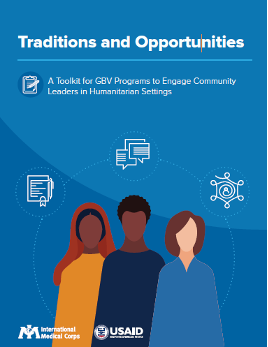
Traditions and Opportunities
A Toolkit for GBV Programs to Engage Community Leaders in Humanitarian Settings
Gender-based violence (GBV) programs have long recognized the importance of engaging community leaders as gatekeepers, service providers and agents of change. Yet GBV programs have often lacked tailored guidance and support to explore potential areas of community leader engagement and to navigate challenges related to this work, including risks of inadvertently reinforcing leadership structures that do not center women and girls. With support from the United States Office Bureau for Humanitarian Affairs, International Medical Corps developed this toolkit to provide GBV practitioners with new ideas, guidance, tools and resources to meet these challenges, and to safely and effectively engage community leaders to advance GBV prevention and response in humanitarian settings.
The Traditions and Opportunities Toolkit is designed for GBV programs, including programs implemented by local, national and international organizations, to serve as a resource in their work to address GBV in humanitarian settings—including conflict, natural disaster, displacement and different stages of emergency response. The toolkit does not outline a specific program to follow, but rather includes guidance and tools that GBV program teams can adapt and apply to engage community leaders through existing or planned GBV prevention and response programs, as appropriate to program goals, context, resources and team capacity.
The Toolkit is divided into two sections: 1) Guidance, Tools and Resources, and 2) Training Manual for Staff and Community Leaders.
![]()
Traditions and Opportunities: Guidance, Tools and Resources
This section of the Toolkit includes core concepts and approaches for engaging community leaders in GBV prevention and response. A chapter devoted to Building a Foundation for Engagement outlines steps for GBV programs to take, as well as tools and resources to help teams plan for effective community leader engagement. The remaining chapters focus on key areas of community leader engagement: GBV response, GBV risk mitigation, transformative change and supporting women leaders. They provide core concepts and recommended approaches for each; ideas for engagement; strategies and activities that GBV programs might consider for engaging leaders in respective key areas; and tools and resources to support their work.

Building a Foundation for Engagement
This chapter includes guidance for teams to build a solid foundation for engagement with community leaders to prevent and respond to GBV, including six steps:
- build a team with appropriate qualities, values, knowledge and skills to engage community leaders safely and effectively for GBV prevention and response activities;
- introduce the program to community leaders;
- map community leadership structures within the community;
- identify priority areas for engaging community leaders in GBV prevention and response;
- identify community leaders to engage; and
- create a plan for engaging community leaders in GBV prevention and response.
| Building a Foundation Tools and Resources | |
| Tip Sheet: Communication Skills | EN FR AR |
| Tip Sheet: Starting with Ourselves | EN FR AR |
| Self-Reflection Exercises | EN FR AR |
| Tips Sheet: Identifying Women Leaders | EN FR AR |
| Decisionmaking Tool: Identifying Key Areas of Engagement | EN FR AR |
| Activity Planning Tool | EN FR AR |
GBV Response
GBV response relates to actions taken after incidents of GBV, with particular attention to the treatment of survivors by their community and access to survivor-centered services. All survivors of GBV should have access to support and services, based on their needs and preferences, including GBV case management, psychosocial support, justice and security services. The “GBV Response” chapter includes ideas for engaging community leaders to strengthen community-based response systems, build community awareness of response services, and foster survivor-centered attitudes, norms and behaviors.
| GBV Response | |
| Participatory Guidance: Developing a Referral Pathway | EN FR AR |
| Addressing Barriers to Care | EN FR AR |
| Discussion Guide: Respect for Survivors | EN FR AR |
| Discussion Guide: Hypothetical Scenarios | EN FR AR |
| Practice Sessions for GBV Response | EN FR AR |
| Tip Sheet: What to Say and Do When a Survivor Discloses GBV | EN FR AR |
| Planning Guide and Tool: Advocacy with Leaders on Behalf of Survivors | EN FR AR |
| Fact Sheet: Early Forced Marriage | EN FR AR |
| Fact Sheet: Intimate Partner Violence | EN FR AR |
| Fact Sheet: Sexual Assault and Rape | EN FR AR |
| Fact Sheet: Female Genital Mutilation/ Cutting | EN FR AR |
GBV Risk Mitigation
The Inter-Agency Standing Committee (IASC) Guidelines for Integrating Gender-Based Violence Interventions in Humanitarian Action refer to GBV risk mitigation as “reducing the risk of exposure to GBV (e.g., ensuring that reports of ‘hot spots’ are immediately addressed through risk-reduction strategies; ensuring sufficient lighting and security patrols are in place from the onset of establishing displacement camps; etc.).” Risk mitigation is focused on making communities and services safer for women and girls; community leaders can influence or lead much of this work. The “GBV Risk Mitigation” chapter includes ideas for engaging community leaders to identify and address GBV risks.
| GBV Risk Mitigation | |
| Safety Audit Checklist | EN FR AR |
| Community Mapping Tool | EN FR AR |
| Sample Key Messages for Outreach | EN FR AR |
| Discussion Guide: GBV Risks | EN FR AR |
| Discussion Guide: Protection from Sexual Exploitation and Abuse | EN FR AR |
| Sample Tools: Protection Taskforce | EN FR AR |
| Sample Communication Tree | EN FR AR |
Transformative Change
Transformative change programming involves addressing root causes of GBV, to prevent its occurrence. Preventing GBV requires changes in unequal power relationships between women and men that are replicated across different levels of society, from individual expectations and attitudes to social norms, policies, legal frameworks and systems. Community leaders can influence changes at different levels of their communities. The “Transformative Change” chapter includes information on selecting or designing GBV prevention programs and ideas for engaging community leaders to build awareness, knowledge and skills; foster gender equitable, respectful and non-violent social norms, attitudes and behaviors; and promote women’s and girls’ empowerment.
| Transformative Change | |
| Sample: Root Cause Analysis | EN FR AR |
| Steps for Developing Key Messages | EN FR AR |
| Checklist: Communication Materials | EN FR AR |
| Tip Sheet: Pretesting Communication | EN FR AR |
| Tip Sheet: Involving Community Leaders in Events | EN FR AR |
| Discussion Guide: Equitable Norms, Attitudes, and Behaviors | EN FR AR |
| Prevention Action Planning Tool | EN FR AR |
| Recommendations: Creating a New Social Behavior Change Program | EN FR AR |
| Resources for Learning about GBV Prevention Theories and Approaches | EN FR AR |
Supporting Women Leaders
Though women leaders can represent and promote women’s voices, needs and perspectives within their communities, women leaders rarely have adequate representation and influence in community and humanitarian decisionmaking. Some of this section’s chapters focus attention on how women leaders can contribute to GBV response, GBV risk mitigation and transformative change. The “Supporting Women Leaders” chapter devotes additional attention to engaging women leaders, including ideas for GBV programs to support women in leadership positions, support emerging leaders and foster an enabling environment for women’s leadership.
| Supporting Women Leaders | |
| Template: Community-Based Organization (CBO) Information | EN FR AR |
| Template: Mentorship Action Plan | EN FR AR |
| Information Sheet: Addressing Constraints on Women’s Participation in Leadership | EN FR AR |
| Planning Tool: Advocacy with Leaders | EN FR AR |
| Discussion Guide: Exploring Potential and Benefits of Women’s Leadership | EN FR AR |
| Talking Points: Women’s Leadership | EN FR AR |
![]()
Traditions and Opportunities: Training Manual
The Toolkit Training Manual includes plans for GBV program teams to build knowledge and skills for community leader engagement, as well as plans for GBV teams to deliver training on GBV prevention and response to groups of community leaders. Training content includes Core GBV Concepts; Foundations: Key Approaches for Engaging Community Leaders; Foundations: Planning for Community Leader Engagement; GBV Response; GBV Risk Mitigation; Transformative Change; and Women’s Leadership.

GBV Core Concepts
This training is foundational and recommended for all GBV staff and all community leaders. GBV Core Concepts training modules establish a common understanding of power and the root cause of GBV, the importance of a survivor-centered approach, the consequences of GBV and the support available for survivors. A GBV core-concepts review module is included in the training section and recommended to include at the start of any subsequent trainings with community leaders.
Foundations: Key Approaches for Engaging Community Leaders
This section covers theoretical and practical approaches for GBV teams to apply when engaging community leaders. The training modules related to communication skills and advocacy may also be relevant for women leaders.
Foundations: Planning for Community Leader Engagement
This section is closely linked with the “Building a Foundation” chapter of the Toolkit Guidance, and is designed to help GBV program teams plan for community leader engagement.
GBV Response
GBV Response training modules can be adapted to focus on specific forms of GBV, to deepen understanding of drivers and consequences of GBV within communities, and to build knowledge and skills for a survivor-centered response. This training section is indicated for all community members and GBV teams.
GBV Risk Mitigation
This section focuses on identifying community-level GBV risks and on setting plans to address risks. The modules are designed for community leaders, but are also relevant for GBV teams.
Transformative Change
This section explores root causes of GBV and considers community-level changes that could prevent GBV. Two modules in this section are devoted to theories and approaches for social behavior-change programming, and are only indicated for GBV teams, while other modules are relevant for both GBV teams and community leaders.
Women’s Leadership
This section explores concepts of leadership and invites participants to reflect on their individual and collective strengths and vision. Women’s leadership training modules are designed for emerging and current women leaders, and can also be relevant for GBV teams.